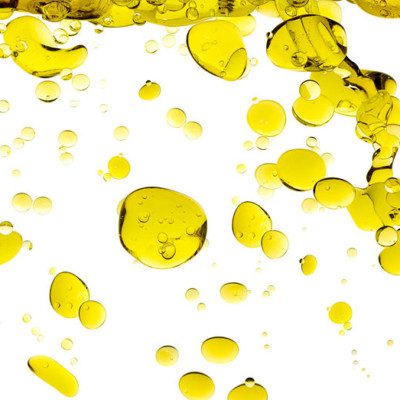Origin
Polyunsaturated fats are widely distributed in nature in both animals and plants. The following list summarizes main sources of PUFAs:
- Palm kernel (nut) oil
- Flaxseed oil
- Sunflower oil
- Coconut oil
- Soybean oil
- Canola oil
- Sunflower oil
- Peanut oil
- Fish oil
- Cottonseed oil
The following table summarizes the composition of fatty acids (saturated, monounsaturated and polyunsaturated) present in various plant sources:
| Vegetable oil | Fatty acid composition1 | |||||||
| Lauric (12:0) | Myristic (14:0) | Palmitic (16:0) | Stearic (18:0) | Oleic (18:1) | Palmitoleic (16:1) | Linoleic (18:2) | Linolenic (18:3) | |
| Soybean | 0.0 | 0.1 | 11.0 | 4.0 | 23.4 | 0.1 | 53.2 | 7.8 |
| Canola | 0.0 | 0.0 | 3.9 | 1.9 | 64.1 | 0.2 | 18.7 | 9.2 |
| Cottonseed | 0.0 | 0.9 | 24.7 | 2.3 | 17.6 | 0.7 | 53.3 | 0.3 |
| Sunflower | 0.5 | 0.2 | 6.8 | 4.7 | 18.6 | 0.1 | 68.2 | 0.5 |
| Peanut | 0.0 | 0.1 | 11.6 | 3.1 | 46.5 | 0.2 | 31.4 | 0.0 |
Function
Polyunsaturated fats are mainly used to enhance the nutritional value of foods. In baked goods, polyunsaturated fats also contribute to dough lubrication, flavor and crumb tenderness.
In the baking industry, polyunsaturated fats have only limited functionality since most bakery operations rely on properties such as high melting point, high thermal stability, air incorporation ability in cake batters through the use of granulated sugar and solid (highly crystalline) fats, etc.
Nutrition
Polyunsaturated fats provide a source of Omega-3, Omega-6, and Omega-9, fatty acids that the human body cannot create on its own. Omega-3 fatty acids’ unique nutritional properties are a result of their conversion to a particular group of prostaglandins. Essential fats such as omega-3 and omega-6 must be consumed through a healthy diet in order to promote proper brain function as well as aid in healthy growth and development.
Polyunsaturated fats are considered healthy fats to consume because of their cholesterol lowering effects and reduced risk of cardiovascular and heart diseases.
Application
Polyunsaturated fats are now being used in clean label baked goods, such as variety, multigrain and artisan-type bread. The major drawback of these fats is the fact that they cannot form stable foams (or creams) when agitated with granulated sugar (or other crystalline forms of sugars). This is a very important aspect when considering using fats that are rich in PUFAs for the production of batter and chiffon cakes.
It is important to work with oil and enzyme suppliers when formulating clean label bread that is high in PUFAs and may have added lipases as GMS replacement. Lipase 3 transforms triglycerides (TAG) into diglycerides (DAG), monoglycerides (MAG), and free fatty acids (FFAs). If overdosed, lipase may produce a very high amount of unsaturated free fatty acids that are unstable and react very quickly with oxygen present in dough or batter, leading to rancidity.
Characteristics and considerations
- Greater potential to undergo oxidation: the higher the number of double bonds, the more prone the fat is to oxidation. Therefore, the need for microencapsulated versions of PUFA and/or higher doses of antioxidants.
- Higher susceptibility to enzymatic rancidity (e.g. lipoxygenase)
- Less shelf-stable (shorter shelf life).
- Greater potential to polymerize in frying applications.
- They are liquid, or non-crystalline, in their natural form, at room temperature conditions.
- Enzymatically produced polar lysolipids containing PUFAs exhibit lower surface activity (i.e. a lower gas bubble stabilizing in breadmaking applications).2
- Lower process stability (consistency) of the fat. High tolerance to melting is a key feature in the commercial production of laminated baked goods and pastry.
Melting point of selected fatty acids1,2
| Fatty acid | Carbons:double bonds | Melting point (°F / °C) | Physical state at 24°C (75°F) |
| Stearic (saturated) | 18:0 | 157 / 69.4 | Solid |
| Palmitic (saturated) | 16:0 | 145 / 62.8 | Solid |
| Oleic | 18:1 | 61 / 16.1 | Liquid |
| Linoleic | 18:2 | 21 / -6.1 | Liquid |
| Linolenic | 18:3 | 9 / -12.8 | Liquid |
References
- Wang, T. “Soybean Oil.” Vegetable Oils in Food Technology: Composition, Properties and Uses, 2nd edition, Blackwell Publishing Ltd., 2011, pp. 59–62.
- Stauffer, C.E. Fats and Oils, Eagan Press Handbook Series, 1996.

